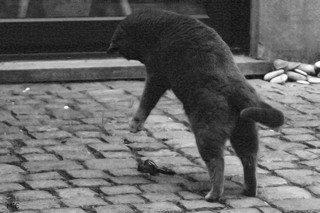Pounce
Pouncing is the behaviour utilised to capture prey and occurs when the cat is within close range of the prey. The cat adopts a crouching posture with the body close to the ground. The hind legs are moved slightly backwards and may tread (i.e. the hind feet are raised and lowered alternately, one at a time with increasing intensity). This movement can also be accompanied by swishing of the tip of the tail which is held straight out directly behind the cat. Together, these movements give the cat an appearance of swaying slightly from side to side. During this time, all senses are directed at the prey item; the eyes are fixated, the ears are directed forwards, the head is lowered and the neck is stretched forwards. At this stage, the cat may bob its head up and down slightly in a manner suggesting that the cat is judging the distance to its catch. The cat will then spring rapidly upwards and in a forwards direction, directing its outstretched front paws and mouth towards the prey. Usually, the hind paws will stay on the ground, however occasionally they can leave the ground, although this is usually only in long grass (Bradshaw, 1992; Leyhausen, 1979) or during an attempt to catch a bird that has taken flight. A successful pounce will lead to a clean capture of the prey in one or both of the front paws and on occasion, a direct capture using the teeth. This photograph illustrates the spring upwards and forwards part of the pounce where the cat aims to capture the prey with its paws.
The following video illustrates a pounce on a mock prey item (a catnip mouse). Consider the other behaviours that precede the pounce (e.g. stare at prey and flattening of the body) and note that the pounce only occurs when the prey item (mock or real) is in close vicinity to the cat. Watch the following video and see if you can count the number of pounces? Do you think you guessed correctly? Watch the following video to find the answer.
|
||||

Compiled by:
Dr Sarah Ellis, Helen Zulch and Jenna Kiddie
